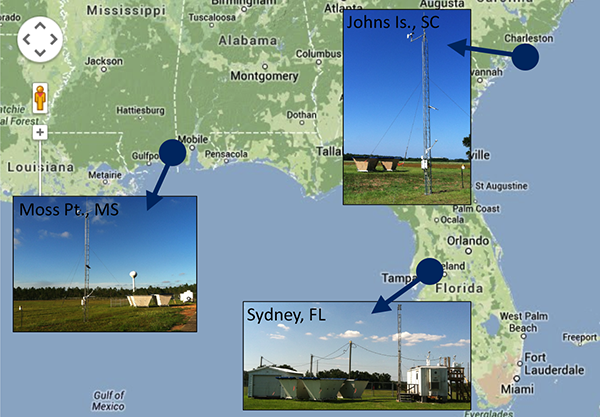Forecaster briefing on Sandy Supplemental instrument deployments
July 18, 2014
On July 9th, HMT personnel from the NOAA Earth System Research Laboratory, provided webinar training for weather forecasters and other interested end users on the atmospheric river observatory (ARO) deployments in coastal sections of Florida, Mississippi, and South Carolina. These deployments complement a coastal ARO and other instrumentation already deployed in North Carolina for the HMT-Southeast Pilot Study (HMT-SEPS). The observatories are designed to provide measurements to detect and monitor landfalling atmospheric rivers (ARs) and other high impact weather. Each ARO consists of a wind-profiling radar, a GPS receiver to measure the amount of water vapor in the atmosphere, and a 10-m tower to provide near-surface measurements of key meteorological variables. The ARO at New Bern, North Carolina, in particular, was well situated to observe Hurricane Arthur as it passed by the Carolinas (see accompanying data image). These four coastal AROs will be in place for the 2014 and 2015 hurricane seasons. During other times of the year, the data will be available for a host of other weather forecast applications.
During the training session, Rob Cifelli started out by giving an overview of HMT-SEPS. Allen White followed with a description of the ARO instrumentation funded by the Sandy Supplemental and the individual data displays and products that are available. Tim Coleman then gave a description of the web tools that provide access to HMT real-time and archived data and display products, as well as other pertinent instrument metadata. Kelly Mahoney ended the session with a description of the research topics that are being addressed in HMT-SEPS. The line was then opened up for questions and discussion.
The Sandy Supplemental is also funding HMT researchers to gain a better understanding of whether ARs exist in the Southeast U.S., and if they do, what criteria should be used to define them and what is their role in creating extreme precipitation that can lead to flooding. Results from some of this research will be presented at the 2014 Fall Meeting of the American Geophysical Union in San Francisco, where there will be a special session devoted to atmospheric rivers.
Contact: Allen White
